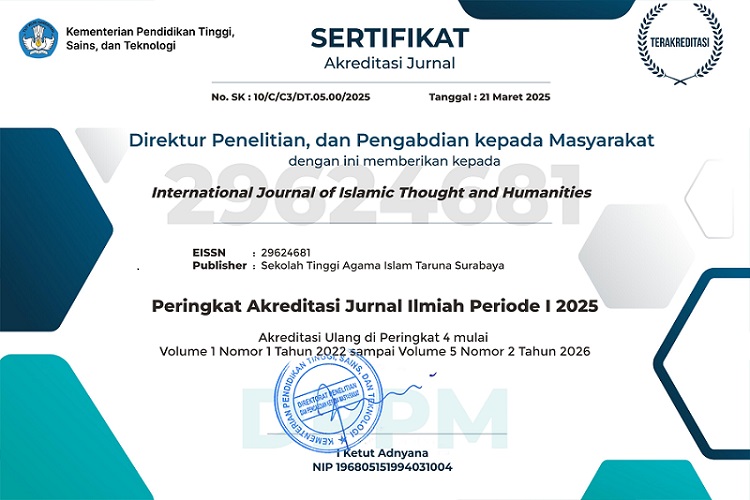2013 Curriculum: Implementation of Islamic Religious Education Learning in Schools for Children with Special Needs
DOI:
https://doi.org/10.54298/ijith.v2i1.83Keywords:
2013 Curriculum, Islamic, Religious, Education, Children with Special NeedsAbstract
The 2013 curriculum is the latest guideline for implementing education in Indonesia. Its application applies to public schools and special schools. This study aims to determine how to implement the 2013 curriculum in learning Islamic religious education for children with special needs (ABK) at SLB Negeri 01 Jakarta. This study uses qualitative research with a descriptive approach to data collection techniques with interviews, observation, and documentation. Data were collected based on field notes, comments, and documentation. The results of the study concluded that the implementation of the 2013 Curriculum for Children with Special Needs (ABK) at SLB Negeri 01 Jakarta uses the same PAI curriculum as the curriculum in traditional schools, and the scope of Islamic Religious Education materials taught is no different from other schools including; al-Qur'an hadith, faith, morals, fiqh and the history of Islamic culture. The learning methods for Islamic Religious Education in special schools are lectures, practices, questions and answers, demonstrations, and exercises. The learning media used include audio-visual media, tape recorders, films, radio, television, digital al-Qur'an, and braille Qur'an are also puzzles. Learning Evaluation consists of three domains cognitive, affective, and psychomotor.
Downloads
References
Anjariani, T. (2022). Pembelajaran PAI Anak Tunagrahita dalam Menumbuhkan Dimensi Religius dan Karakter Mandiri. EDUKASIA: Jurnal Pendidikan Dan Pembelajaran, 4(1), 109–118. http://jurnaledukasia.org/index.php/edukasia/article/view/108
Arief, A. (2010). Ilmu Pendidikan Islam. Wahana Kardofa.
Aripin, S., & Nurdiansyah, N. M. (2022). Modernization of Education: a New Approach and Method in Learning Islamic Religious Education. Tadris: Jurnal Pendidikan Islam, 17(1), 100–117. https://doi.org/http://doi.org/10.19105/tjpi.v17i1.5916
Attwood, T. (1998). Toni Asperger Syndrome: A Guide for Parents And Professional. Jessica Kingsley Publisher.
Awaludin, D. (2022). NILAI SPIRITUAL MATA KULIAH ENTREPRENEUR DI POLITEKNIK LP3I JAKARTA SUDIRMAN TANGERANG. Andragogi: Jurnal Pendidikan Islam Dan Manajemen Pendidikan Islam, 4(1), 104–122. https://doi.org/doi.org/10.36671/andragogi.v1i3.66
Azizah, N. (2023). Implementasi Pembelajaran PAI pada Pendidikan Inklusi bagi Anak Berkebutuhan Khusus. alfathan, 1(2), 20-33. AL-FATHAN : JURNAL PENDIDIKAN AGAMA ISLAM, 1(2), 20–33. https://doi.org/ISSN: 2964-917X
Cahyaningrum, E. S., Sudaryanti, S., & Purwanto, N. A. (2017). PENGEMBANGAN NILAI-NILAI KARAKTER ANAK USIA DINI MELALUI PEMBIASAAN DAN KETELADANAN. JURNAL PENDIDIKAN ANAK, 6(2), 203–213. https://doi.org/https://doi.org/10.21831/jpa.v6i2.17707
Cohen, S. B., & Bolton, P. (1993). Autism: the facts. Oxford University Press. https://books.google.co.id/books?hl=en&lr=&id=Q86EUAZM0b4C&oi=fnd&pg=PA1&dq=Baron-Cohen+S.,+Bolton+P,+Autism:+The+Facts,+(Oxford:+Oxford+Paperbacks,+1993),+hal+11&ots=O1M5Cqw9-9&sig=IsDP2xC7Mv0bYYjifyk3V3tCOUo&redir_esc=y#v=onepage&q&f=false
Daheri, M., Pattiasina, P. J., Saputra, N., Nurdiansyah, N. M., & Uzlifah, L. (2022). Pengaruh Reward Dan Punishment Terhadap Profesionalisme Guru. Munaddhomah: Jurnal Manajemen Pendidikan Islam, 3(4), 388–397. https://doi.org/https://doi.org/10.31538/munaddhomah.v3i4.304
Daradjat, Z. (2017). Ilmu Pendidikan Islam. PT. Bumi Aksara.
Depdiknas. (2003). Undang-Undang RI No. 20 Tahun 2003 Tentang Sistem Pendidikan Nasional. Kelembagaan Ristekdikti. https://kelembagaan.ristekdikti.go.id/wpcontent/uploads/2016/08/UU_no_20_th_2003
Direktorat Pembinaan Sekolah Luar Biasa. (2006).
Efendi, M. (2006). Pengantar Psikopedagogik anak berkelainan. PT. Bumi Aksara.
Erdina, M. S., & Prabowo A, E. (2016). MODUL GURU PEMBELAJAR SLB TUNANETRA KELOMPOK KOMPETENSI E.
Eslianna, E., Lian, B., & Sari, A. P. (2020). Implementation of School Based Management in Improving the Quality of Education. International Journal of Progressive Sciences and Technologies, 23(1), 316–323.
Undang-Undang No. 2 tahun 1989 tentang Sistem Pendidikan Nasional., Pub. L. No. 2 (1989).
Jannah, I. K., & Rozi, F. (2021). REVITALISASI PEMBERDAYAAN BUDAYA KARAKTER NUANSA RELIGIUSTIK DALAM MEMBENTUK PERILAKU PEKERTI SANTRI. MUROBBI: Jurnal Ilmu Pendidikan, 5(1), 17–34. https://doi.org/https://doi.org/10.52431/murobbi.v5i1.334
Khoirurrizki, A. A., & Widodo, H. (2022). PENGEMBANGAN KURIKULUM 2013 DALAM PEMBELAJARAN PENDIDIKAN AGAMA ISLAM PASCA PANDEMI COVID-19 DI SLB MUHAMMADIYAH DEKSO. Jurnal Hurriah: Jurnal Evaluasi Pendidikan Dan Penelitian, 3(1), 25–33. https://academicareview.com/index.php/jh/article/view/62/45
Kunc, N. (1992). (1992). The need to belong: Rediscovering Maslow's hierarchy of needs. In R. A. Villa, J. S. Thousand, W. Stainback, & S. Stainback (Eds.), Restructuring for caring and effective education: An administrative guide to creating heterogeneous schools. 25–39. https://psycnet.apa.org/record/1992-97650-001
Kurniasari, N. D. (2016). Pola Pembelajaran dan Pengasuhan Pendidikan Anak Usia Dini di PAUD Madura. Jurnal Komunikasi, 10(1), 113. https://doi.org/10.21107/ilkom.v10i1.1844
Maulipaksi, D., & Langguana, A. (2017). Sekolah inklusi dan pembangunan SLB dukung pendidikan inklusi. Retrieved on July, 19, 2017.
McCroskery, M. (2010). Asperger' s Syndrome : A Developmental Puzzle. IRCA ARTICLES GENERAL, 5(3), 2–3.
Moore, C. (1998). Educating Students With Disabilities in General Education Classrooms: a Summary of Research Alaska. Departement of Education, Teaching and Learning Support.
Mutiawati, Y. (2019). PEMBENTUKAN KARAKTER RELIGIUS PADA KEGIATAN MAKAN ANAK DI PENDIDIKAN ANAK USIA DINI. BUAH HATI, 6(2), 165–174. https://doi.org/https://doi.org/10.46244/buahhati.v6i2.589
Nata, A. (2000). Metodologi Studi Islam. PT. Raja Grafindo Persada.
Nur, M. I., Zaini, M. A., & Marzuki, I. (2022). Implementasi Kurikulum K13 pada Anak Berkebutuhan Khusus. Bidayatuna: Jurnal Pendidikan Guru Madrasah Ibtidaiyah, 05(01), 105–114. https://doi.org/https://doi.org/10.54471/bidayatuna.v5i1.1336
Nurdiansyah, N. M., Arief, A., Agustin, F. R., Hudriyah, H., Muassomah, M., & Mustofa, S. (2021). EDUCATION RECONSTRUCTION: A COLLABORATION OF QUIZ TEAM AND KAHOOT METHODS IN LEARNING ARABIC. KOMPOSISI: Jurnal Pendidikan Bahasa, Sastra, Dan Seni, 22(2), 93–106. https://doi.org/https://doi.org/10.24036/komposisi.v22i2.111436
Nurdiansyah, N. M., & Hudriyah, H. (2021). POLICY AND IMPLEMENTATION OF EDUCATION MANAGEMENT BASED ON MADRASAH. AL-TANZIM: Jurnal Manajemen Pendidikan Islam, 5(1), 14–27. https://doi.org/10.33650/al-tanzim.v5i1.1416
Nurdiansyah, N. M., Jam`siawati, D., Arief, A., Khaeroni, & Habudin. (2022). Science Learning Patterns for Primary School/ Madrasah Ibtidaiyah: The Use of Circulatory Bottle Props on the Circulatory System. Jurnal Basicedu, 6(1), 166–178. https://doi.org/https://doi.org/10.31004/basicedu.v6i1.1841
Nurdiansyah, N. M., Kahfi, A., & Maulidiah, D. I. (2022). Pembelajaran Tematik: Upaya Hasil Belajar Sistematik Menggunakan Metode Problem Based Learning. Jurnal Basicedu, 6(2), 2034–2044. https://doi.org/10.31004/basicedu.v6i2.2344
Payne, A. A., & Welch, K. (2016). The Centrality of Schools in the Lifecourse: The Case for Focusing on School-Related Influences in Developmental Theory and Research. Deviant Behavior, 37(7), 748–760. https://doi.org/10.1080/01639625.2015.1071134
Ramayulis. (2001). Metodologi pengajaran agama Islam. Kalam Mulia.
Ramayulis. (2010). Ilmu Pendidikan Islam. Kalam Mulia.
Sandiko, Faiz, Rozi, F., Wahyuni, U., & Yulastari. (2022). School Management in Forming Children ’ s Religious Character. AL-TANZIM: Jurnal Manajemen Pendidikan Islam, 06(03), 655–666. https://doi.org/https://doi.org/10.33650/al-tanzim.v6i3.3383
Sanyoto, M. H. (2020). Pendidikan Untuk Anak Berkebutuhan Khusus. Hom Visit Therapy: Syifa Psychology Consultant.
Saylor, J. G., Alexander, William, M. and, & J., L. A. (1981). Curriculum Planning For Better Teaching and Learning. Holt-Reinhart and Winston.
Siti Rohmah, M. (2010). Pendidikan agama Islam dalam setting pendidikan inklusi. https://repository.uinjkt.ac.id/dspace/handle/123456789/6255
Skjorten, M. D. (2001). Towards inclusion and enrichment, Artikel in Johnsen. Unipubforlag.
Sugiyono, D. (2013). Metode penelitian pendidikan pendekatan kuantitatif, kualitatif dan R&D. Alfabeta. https://digilib.unigres.ac.id/index.php?p=show_detail&id=43
Suparno. (2007). Pendidikan Anak Berkebutuhan Khusus. Dirjen Dikti Depdiknas.
Taba, H. (1962). Curriculum Development: Theory and Practice. Hartcourt, Brace & Wolrd, Inc.
Undang-Undang Dasar 1945 Pasal 31 Ayat 1, Pub. L. No. 31 Ayat 1.
Vioreanu, A.-M. (2022). Abnormal psychology in a changing world (10th ed.). Educational Research and Evaluation An International Journal on Theory and Practice, 27(5–8), 420–422. https://doi.org/10.1080/13803611.2022.2061515
White, J. (2004). Rethinking the School Curriculum: Values, Aims and Purposes London:
Wulandari, W., Mansur, A., & Ali, M. (2022). IMPLEMENTASI PEMBELAJARAN JARAK JAUH (PJJ) PADA MATA PELAJARAN PENDIDIKAN AGAMA ISLAMDI SEKOLAH LUAR BIASA (SLB) NEGERI MUARA ENIM. Jurnal PAI Raden Fatah, 4(1), 79–92. https://doi.org/https://doi.org/10.19109/pairf.v4i1.9679
Zulaikah, S. (2015). Pendidikan Keimanan (Studi Komparasi antara Pemikiran Abdullah Nasih’Ulwan dan Abdurrahman AnNahlawi) [Doctoral dissertation, STAIN Ponorogo]. http://etheses.iainponorogo.ac.id/852/1/BAB I-V.pdf
Downloads
Published
How to Cite
Issue
Section
License
Copyright (c) 2023 Yayah Nurmaliyah, Syamsul Aripin, Nana Meily Nurdiansyah

This work is licensed under a Creative Commons Attribution-ShareAlike 4.0 International License.
Authors who publish with this journal agree to the following terms:
- Authors retain copyright and grant the journal right of first publication with the work simultaneously licensed under a Creative Commons Attribution-ShareAlike 4.0 that allows others to share the work with an acknowledgement of the work's authorship and initial publication in this journal.
- Authors are able to enter into separate, additional contractual arrangements for the non-exclusive distribution of the journal's published version of the work (e.g., post it to an institutional repository or publish it in a book), with an acknowledgement of its initial publication in this journal.
- Authors are permitted and encouraged to post their work online (e.g., in institutional repositories or on their website) prior to and during the submission process, as it can lead to productive exchanges, as well as earlier and greater citation of published work (See The Effect of Open Access).


















